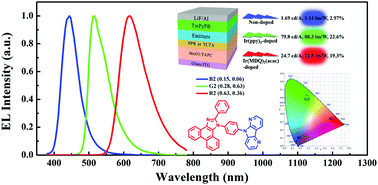Bipolar phenanthroimidazole–diazacarbazole hybrids with appropriate bandgaps for highly efficient and low roll-off red, green and blue electroluminescent devices†
Abstract
By incorporating the novel electron-accepting 1,5-diazacarbazole into different positions on a rigid phenanthroimidazole skeleton, two para-linked bipolar phenanthroimidazole–diazacarbazole hybrids, 2-(4-(5H-pyrrolo[2,3-b:4,5-b′]dipyridin-5-yl)phenyl)-1-phenyl-1H-phenanthro[9,10-d]imidazole (PPI-pCNCz) and 1-(4-(5H-pyrrolo[2,3-b:4,5-b′]dipyridin-5-yl)phenyl)-2-phenyl-1H-phenanthro[9,10-d]imidazole (PPI-pNNCz), have been designed and synthesized. Their physical, chemical and electronic properties can be regulated through altering the linking topology (C- or N-connectivity of the phenanthroimidazole). The C-connected compound PPI-pCNCz has a high glass-transition temperature of 191 °C and a relatively narrow bandgap of 3.04 eV, which contribute to reducing the device operating voltage and enhancing the power efficiency. Meanwhile, the N-connected analogue PPI-pNNCz possesses a high triplet energy of 2.63 eV and balanced carrier-transport ability, which benefit the electron–hole recombination within the emission layer. More interestingly, both of them can be used to construct high-performance three-primary color (R, G and B) OLEDs through a simple material system and a similar device architecture. In particular for PPI-pNNCz, the undoped deep-blue fluorescent device exhibits an external quantum efficiency of 2.97% with CIE coordinates of (0.15, 0.06), and highly efficient green (79.8 cd A−1, 88.3 lm W−1 and 22.6%) and red (24.7 cd A−1, 22.5 lm W−1 and 19.3%) PhOLEDs are also achieved by using it as the universal host material. These performances currently represent the state-of-the-art results for full-color OLEDs.


 Please wait while we load your content...
Please wait while we load your content...